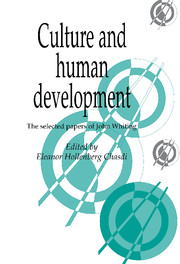Book contents
- Frontmatter
- Contents
- List of figures
- Preface
- Acknowledgments
- Introduction: John Whiting and anthropology
- Fifty years as a behavioral scientist: autobiographical notes
- Part I Theory and methods
- Part II Environment and history
- Part III Moral development
- Introduction
- 6 Sorcery, sin, and the superego: a cross-cultural study of some mechanisms of social control
- 7 Resource mediation and learning by identification
- Part IV Gender development
- Part V Development of social behavior
- Bibliography
- Complete bibliography of John W. M. Whiting's work
- Index
7 - Resource mediation and learning by identification
Published online by Cambridge University Press: 23 December 2009
- Frontmatter
- Contents
- List of figures
- Preface
- Acknowledgments
- Introduction: John Whiting and anthropology
- Fifty years as a behavioral scientist: autobiographical notes
- Part I Theory and methods
- Part II Environment and history
- Part III Moral development
- Introduction
- 6 Sorcery, sin, and the superego: a cross-cultural study of some mechanisms of social control
- 7 Resource mediation and learning by identification
- Part IV Gender development
- Part V Development of social behavior
- Bibliography
- Complete bibliography of John W. M. Whiting's work
- Index
Summary
This paper presents the current state of a theory of identification, or, more properly, learning by identification, that has been developed at the Harvard Laboratory of Human Development during the last ten years. It is impossible to give proper credit to the various members of the staff who have contributed their ideas to the current formulation. On the other hand, certain former and present members of the staff will disagree with some of the assumptions stated here and should not be held responsible for them.
Many of the ideas presented here may have a very familiar ring. We, of course, have drawn heavily upon Sigmund and Anna Freud and many of the neo-Freudians, as well as the behavioristic theories such as those of Hull, Miller and Dollard, Mowrer, and the cognitive theories of Tolman and others. We will make no attempt in this paper to give proper citation for the sources of these ideas.
Although we do not presume that learning by identification occurs only in the home or that a child identifies only with his parents, we have focused on this relationship to build our model. This has led us to consider in detail the types of interaction between a parent, particularly a mother, and a child that may occur during the course of socialization. Furthermore, we have limited our interest to the learning of social roles rather than the skills for coping with the nonsocial environment.
The term “identification” has been used in many ways.
- Type
- Chapter
- Information
- Culture and Human DevelopmentThe Selected Papers of John Whiting, pp. 194 - 204Publisher: Cambridge University PressPrint publication year: 1993



